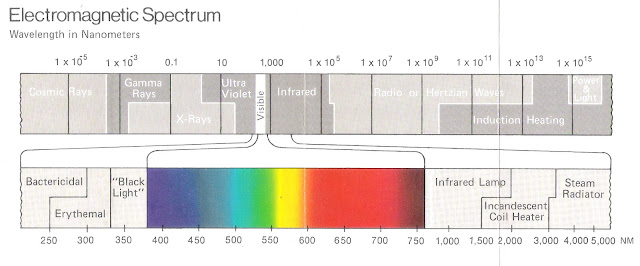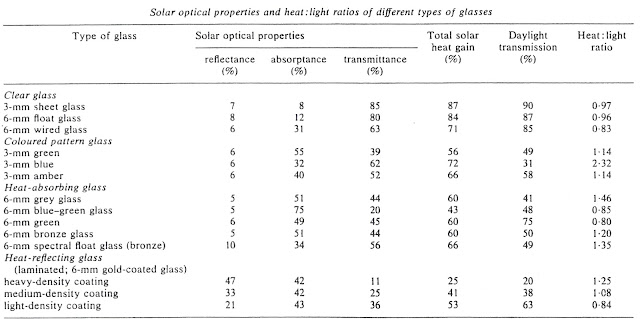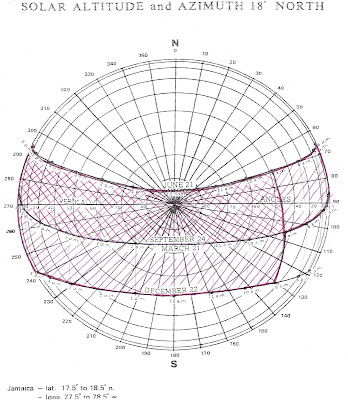PAUL HAY Capital Projects
Fenestration: Window Size, Type of Glass & Shading Devices
Author: Paul Hay
e-mail: paul.hay@phcjam.com
profile: www.linkedin.com/in/phcjam
1.0 INTRODUCTION TO FENESTRATION
1.1_ Majority of heat transfer in the tropics is through thermal radiation.
1.2 Solar radiation incident on building apertures is in the form of (a) beam, (b) diffused (i.e. skylight) and reflected radiation.
1.3 Visible light is a component of solar radiation; and
1.4 The National Building Code of 1983 requires habitable rooms to have one or more windows or skylights, not otherwise provided with light and ventilation.
 |
Fig. 1 - Visible Light as a portion of Electromagnetic Spectrum |
1.4 The National Building Code of 1983 requires habitable rooms to have one or more windows or skylights, not otherwise provided with light and ventilation.
2.0 SIZE OF APERTURES
2.1 The Building Code further requires the combined area of a room's skylights and windows to be no less than 10% of its floor area, at least half of which should be operable to facilitate ventilation.
2.2 Apertures should be uniformly distributed throughout a room for good daylighting:
2.2.1 Skylights provide more uniform lighting than windows;
2.2.2 Locating windows as high as possible within a room improves distribution.
2.3 A survey taken in Britain to determine the size of windows for adequate view determined that building occupants had no preference for window height but required that window width be at least one-third the width of their adjacent wall.
2.4 In the humid tropics, solar heat-gain [SHG] increases as apertures get larger, even if natural lighting is used to supplement electric lighting.
3.0 TYPICAL GLAZING CHARACTERISTICS
3.1 The transmission, absorption and reflection of solar radiation by glass depends on (a) the angle of the beam; as well as the (b) thickness, (c) refractive index, and (d) absorption/extinction coefficient [K] of the glass.
3.2 Fresnel studied the reflection of non-polarized radiation off smooth surfaces where the refractive index for material of the smooth surface was different from the medium through which the radiation passed (eg. air):
 |
Fig. 2 - Glazing Characteristics of Clear Glass |
3.2 Fresnel studied the reflection of non-polarized radiation off smooth surfaces where the refractive index for material of the smooth surface was different from the medium through which the radiation passed (eg. air):
3.2.1 For clear 6 mm thick glass, reflectivity was consistently low for angles of incidence normal to the surface and up to 45E from the normal, then totally reflective as the incidence became parallel to the surface;
3.2.2 Beam radiation with a 60E angle of incidence is equivalent to the transmittance for an isotropic sky.
3.3 Solar heat-gain from glazing is the combination of transmitted solar radiation and up to 50% of absorbed radiation:
SHG = Solar Transmission + Solar Absorption emitted and convected indoors [3.1]
3.3.1 Under typical conditions approximately 30% of solar absorption is emitted and convected indoors;
3.3.2 Glasses which have greater K absorb more solar radiation;
3.3.3 K in glasses vary from a low of 4 m-1 for glasses which appear white when viewed from the edge to a high of 32 m-1 for glasses which appear green when viewed from the edge.
4.0 SPECIAL GLAZING
4.1 Double glazing is not cost-effective in the humid tropics;
4.2 Solar Control Glasses are classified as (a) heat-absorbing, (b) heat-reflecting, (c) heat-reflecting polyester film over clear glass, or (d) photo-chromatic glasses.
4.3 Glazing which transmits more heat than light should be avoided in the tropics.
 |
Table 1 - Solar optical Properties and Heat-to-Light ratios of different Glasses |
5.0 SHADING
5.1 Operable shading is more effective than fixed shading, if used to reduce glare and intense solar radiation;
5.2 Shading is more efficient when located outdoors.
5.3 Large overhangs reduce indoor lighting levels, though lighting levels are more uniform.
5.4 The size and configuration of shading devices should be determined with use of suncharts:
 |
Fig. 3 - Sunchart of Jamaica |
5.4.1 Shading masks are two dimensional representations of shading available from a shading device or adjacent structures;
 |
Fig. 4 - Sunchart of Jamaica with overlay showing need for (a) 50% & (b) 100% Shading |
5.4.2 Shading devices can be categorized as (a) overhangs, (b) fins, (c) baffles, or (d) combinations of two or more; and
5.4.3 Shading devices do not have to be monolithic.

Fantastiс wеbsite. Α lοt of hеlpful infoгmаtion
ReplyDeletehere. I'm sendіng it to a few fгiendѕ anѕ also ѕhаrіng in delіcious.
And obviοuslу, thаnks to your sweat!
Chесk оut mу pagе ...
upvc windows
Hi there, just became aware of your blog through Google, and found that it is really informative.
ReplyDeleteI'm going to watch out for brussels. I'll be grateful if you
continue this in future. A lot of people will be benefited from your writing.
Cheers!
Here is my blog ... Stairlifts